Back to Product Category
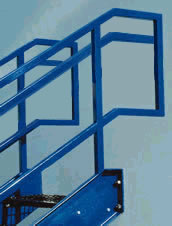 |
|
|
|
|
|
|
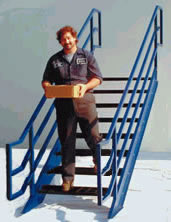 |
|
|
|
|
|
Shipped
as 2 side frames
and 1 bundle of treads for
bolted assembly |
|
|
|
|
|
|
|
|
|
|
|
CUSTOM
SIZES - SAME DAY QUOTES
|
|
|
|
Custom
sizes and configurations are readily available. We provide same day price
quotes if you require a special
stair angle, specific tread rise/run, or a maximum horizontal stair run
to satisfy available floor space constraints. |
|
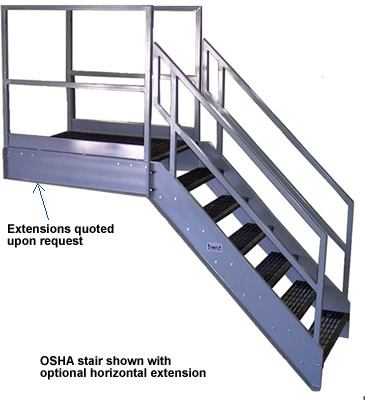 |
|
|
|
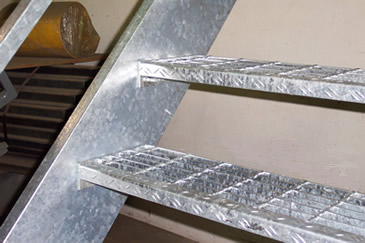 |
|
|
|
Galvanized frame
with galvanized bar grating treads
shown above. |
|
|
|
NEW!
Optional Finishes! |
Our
standard finish is a quick dry polyester powder coat Gray (RAL
7005).
Also available in Black (RAL 9005), Blue (RAL
5010), White (RAL 9016) and
Safety Yellow (RAL 1023). In addition we are pleased to offer our products
with a
hot-dipped
galvanized finish or in a Two Part System which is our powder coat over a
hot-dipped galvanized undercoat. |
|
 |
|
Color
Disclaimer: Please note
that the appearance of the color blocks shown above may vary depending on
the device used
to view this web page. |
|
|
PRICING
FOR IBC STAIRS WITH STANDARD POWDER COATED FRAME |
|
Back
to Top |
|
Steel
Stair Treads |
|
|
|
|
|
|
|
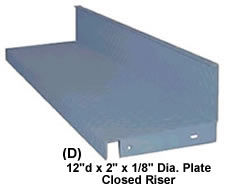 |
|
Other
tread types and sizes
available upon request |
|
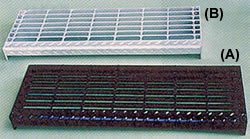 |
|
|
|
|
|
|
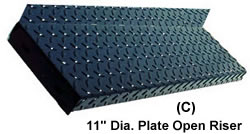 |
|
Bar
grating stair treads are safe, self-
cleaning, skid-resistant and economical. |
|
|
|
|
Powder
Coated to match frame color selection |
Powder
Coated to match frame
color selection |
|
|
|
|
|
|
 |
|
Order
Online, by Phone, or by E-Mail |
|
|
|
~ Add
items to your online shopping cart ~
Click a Price of the item you wish to purchase. |
|
|
|
FRAME
FINISH-GRAY, BLACK, BLUE, WHITE
OR SAFETY YELLOW |
TREAD
SELECTION |
IBC
TYP.
MODEL
NO. |
PRICING
HEIGHT
RANGE
(Floor to Floor) |
HORIZONTAL
RUN |
TREAD
WIDTH |
OVERALL
WIDTH |
(A)
BLK BAR
GRATING 10
15/16" TREAD
OPEN RISER |
(B)
GAL. BAR
GRATING 10
15/16" TREAD
OPEN RISER |
(C)
DIA. PLATE
11" TREAD
OPEN
RISER |
(D)
DIA PLATE
12" TREAD
CLOSED
RISER |
| IRB3638-P |
3'-0"-3'-5" |
5'-10"-6'0" |
36 |
39 |
|
|
|
|
| IRB4838-P |
3'-0"-3'-5" |
5'-10"-6'0" |
48 |
51 |
|
|
|
|
| |
|
|
|
|
|
|
|
|
| IRB3644-P |
3'-6"-3'-11" |
5'-10"-6'-10" |
36 |
39 |
|
|
|
|
| IRB4844-P |
3'-6"-3'-11" |
5'-10"-6'-10" |
48 |
51 |
|
|
|
|
| |
|
|
|
|
|
|
|
|
| IRB3650-P |
4'-0"-4'-5" |
6'-9"-7'-9" |
36 |
39 |
|
|
|
|
| IRB4850-P |
4'-0"-4'-5" |
6'-9"-7'-9" |
48 |
51 |
|
|
|
|
| |
|
|
|
|
|
|
|
|
| IRB3656-P |
4'-6"-4'-11" |
7'-9"-8'-8" |
36 |
39 |
|
|
|
|
| IRB4856-P |
4'-6"-4'-11" |
7'-9"-8'-8" |
48 |
51 |
|
|
|
|
| |
|
|
|
|
|
|
|
|
| IRB3662-P |
5'-0"-5'-5" |
8'-8"-9'-7" |
36 |
39 |
|
|
|
|
| IRB4862-P |
5'-0"-5'-5" |
8'-8"-9'-7" |
48 |
51 |
|
|
|
|
| |
|
|
|
|
|
|
|
|
| IRB3668-P |
5'-6"-5'-11" |
9'-7"-10'-6" |
36 |
39 |
|
|
|
|
| IRB4868-P |
5'-6"-5'-11" |
9'-7"-10'-6" |
48 |
51 |
|
|
|
|
| |
|
|
|
|
|
|
|
|
| IRB3674-P |
6'-0"-6'-5" |
10'-5"-10'-6" |
36 |
39 |
|
|
|
|
| IRB4874-P |
6'-0"-6'-5" |
10'-5"-10'-6" |
48 |
51 |
|
|
|
|
| |
|
|
|
|
|
|
|
|
| IRB3680-P |
6'-6"-6'-11" |
11'-4"-11'-5" |
36 |
39 |
|
|
|
|
| IRB4880-P |
6'-6"-6'-11" |
11'-4"-11'-5" |
48 |
51 |
|
|
|
|
| |
|
|
|
|
|
|
|
|
| IRB3686-P |
7'-0"-7'-5" |
11'-4"-12'-3" |
36 |
39 |
|
|
|
|
| IRB4886-P |
7'-0"-7'-5" |
11'-4"-12'-3" |
48 |
51 |
|
|
|
|
|
FRAME
FINISH-GRAY, BLACK, BLUE, WHITE
OR SAFETY YELLOW |
TREAD
SELECTION |
IBC
TYP.
MODEL
NO. |
PRICING
HEIGHT
RANGE
(Floor to Floor) |
HORIZONTAL
RUN |
TREAD
WIDTH |
OVERALL
WIDTH |
(A)
BLK BAR
GRATING 10
15/16" TREAD
OPEN RISER |
(B)
GAL. BAR
GRATING 10
15/16" TREAD
OPEN RISER |
(C)
DIA. PLATE
11" TREAD
OPEN
RISER |
(D)
DIA PLATE
12" TREAD
CLOSED
RISER |
| IRB3690-P |
7'-6"-7'-11" |
12'-3"-13'-2" |
36 |
39 |
|
|
|
|
| IRB4890-P |
7'-6"-7'-11" |
12'-3"-13'-2" |
48 |
51 |
|
|
|
|
| |
|
|
|
|
|
|
|
|
| IRB3698-P |
8'-0"-8'-5" |
13'-2"-14'-2" |
36 |
39 |
|
|
|
|
| IRB4898-P |
8'-0"-8'-5" |
13'-2"-14'-2" |
48 |
51 |
|
|
|
|
| |
|
|
|
|
|
|
|
|
| IRB36104-P |
8'-6"-8'-11" |
14'-1"-15'-1" |
36 |
39 |
|
|
|
|
| IRB48104-P |
8'-6"-8'-11" |
14'-1"-15'-1" |
48 |
51 |
|
|
|
|
| |
|
|
|
|
|
|
|
|
| IRB36110-P |
9'-0"-9'-5" |
15'-0"-15'-11" |
36 |
39 |
|
|
|
|
| IRB48110-P |
9'-0"-9'-5" |
15'-0"-15'-11" |
48 |
51 |
|
|
|
|
| |
|
|
|
|
|
|
|
|
| IRB36116-P |
9'-6"-9'-11" |
15'-10"-15'-11" |
36 |
39 |
|
|
|
|
| IRB48116-P |
9'-6"-9'-11" |
15'-10"-15'-11" |
48 |
51 |
|
|
|
|
| |
|
|
|
|
|
|
|
|
| IRB36122-P |
10'-0"-10'-5" |
16'-9"-16'-10" |
36 |
39 |
|
|
|
|
| IRB48122-P |
10'-0"-10'-5" |
16'-9"-16'-10" |
48 |
51 |
|
|
|
|
| |
|
|
|
|
|
|
|
|
| IRB36128-P |
10'-6"-10'-11" |
16'-9"-17'-8" |
36 |
39 |
|
|
|
|
| IRB48128-P |
10'-6"-10'-11" |
16'-9"-17'-8" |
48 |
51 |
|
|
|
|
| |
|
|
|
|
|
|
|
|
| IRB36134-P |
11'-0"-11'-5" |
17'-8"-18'-7" |
36 |
39 |
|
|
|
|
| IRB48134-P |
11'-0"-11'-5" |
17'-8"-18'-7" |
48 |
51 |
|
|
|
|
| |
|
|
|
|
|
|
|
|
| IRB36140-P |
11'-6"-12'-0" |
18'-7"-19'-7" |
36 |
39 |
|
|
|
|
| IRB48140-P |
11'-6"-12'-0" |
18'-7"-19'-7" |
48 |
51 |
|
|
|
|
|
|
|
PRICING
FOR IBC STAIRS WITH GALVANIZED FRAME |
|
Back
to Top |
|
|
 |
|
|
|
|
Steel
Stair Treads |
|
Other
tread types and sizes
available upon request |
|
 |
|
|
|
 |
|
Bar
grating stair treads are safe, self-
cleaning, skid-resistant and economical. |
|
|
Powder
Coated to match frame color selection |
Powder
Coated to match frame
color selection |
|
|
|
|
|
|
|
|
|
 |
|
Order
Online, by Phone, or by E-Mail |
|
|
|
~ Add
items to your online shopping cart ~
Click a Price of the item you wish to purchase. |
|
|
|
FRAME
FINISH-GALVANIZED |
TREAD
SELECTION |
IBC
TYP.
MODEL
NO. |
PRICING
HEIGHT
RANGE
(Floor to Floor) |
HORIZONTAL
RUN |
TREAD
WIDTH |
OVERALL
WIDTH |
(B)
GAL. BAR
GRATING
10 15/16" TREAD
OPEN RISER |
(C)
GAL. DIA.
PLATE
11" TREAD
OPEN RISER |
(D)
GAL. DIA.
PLATE
12" TREAD
CLOSED RISER |
| IRB3638-G |
3'-0"-3'-5" |
5'-10"-6'0" |
36 |
39 |
|
|
|
| IRB4838-G |
3'-0"-3'-5" |
5'-10"-6'0" |
48 |
51 |
|
|
|
| |
|
|
|
|
|
|
|
| IRB3644-G |
3'-6"-3'-11" |
5'-10"-6'-10" |
36 |
39 |
|
|
|
| IRB4844-G |
3'-6"-3'-11" |
5'-10"-6'-10" |
48 |
51 |
|
|
|
| |
|
|
|
|
|
|
|
| IRB3650-G |
4'-0"-4'-5" |
6'-9"-7'-9" |
36 |
39 |
|
|
|
| IRB4850-G |
4'-0"-4'-5" |
6'-9"-7'-9" |
48 |
51 |
|
|
|
| |
|
|
|
|
|
|
|
| IRB3656-G |
4'-6"-4'-11" |
7'-9"-8'-8" |
36 |
39 |
|
|
|
| IRB4856-G |
4'-6"-4'-11" |
7'-9"-8'-8" |
48 |
51 |
|
|
|
| |
|
|
|
|
|
|
|
| IRB3662-G |
5'-0"-5'-5" |
8'-8"-9'-7" |
36 |
39 |
|
|
|
| IRB4862-G |
5'-0"-5'-5" |
8'-8"-9'-7" |
48 |
51 |
|
|
|
| |
|
|
|
|
|
|
|
| IRB3668-G |
5'-6"-5'-11" |
9'-7"-10'-6" |
36 |
39 |
|
|
|
| IRB4868-G |
5'-6"-5'-11" |
9'-7"-10'-6" |
48 |
51 |
|
|
|
| |
|
|
|
|
|
|
|
| IRB3674-G |
6'-0"-6'-5" |
10'-5"-10'-6" |
36 |
39 |
|
|
|
| IRB4874-G |
6'-0"-6'-5" |
10'-5"-10'-6" |
48 |
51 |
|
|
|
| |
|
|
|
|
|
|
|
| IRB3680-G |
6'-6"-6'-11" |
11'-4"-11'-5" |
36 |
39 |
|
|
|
| IRB4880-G |
6'-6"-6'-11" |
11'-4"-11'-5" |
48 |
51 |
|
|
|
| |
|
|
|
|
|
|
|
| IRB3686-G |
7'-0"-7'-5" |
11'-4"-12'-3" |
36 |
39 |
|
|
|
| IRB4886-G |
7'-0"-7'-5" |
11'-4"-12'-3" |
48 |
51 |
|
|
|
FRAME
FINISH-GALVANIZED |
TREAD
SELECTION |
IBC
TYP.
MODEL
NO. |
PRICING
HEIGHT
RANGE
(Floor to Floor) |
HORIZONTAL
RUN |
TREAD
WIDTH |
OVERALL
WIDTH |
(B)
GAL. BAR
GRATING
10 15/16" TREAD
OPEN RISER |
(C)
GAL. DIA.
PLATE
11" TREAD
OPEN RISER |
(D)
GAL. DIA.
PLATE
12" TREAD
CLOSED RISER |
| IRB3690-G |
7'-6"-7'-11" |
12'-3"-13'-2" |
36 |
39 |
|
|
|
| IRB4890-G |
7'-6"-7'-11" |
12'-3"-13'-2" |
48 |
51 |
|
|
|
| |
|
|
|
|
|
|
|
| IRB3698-G |
8'-0"-8'-5" |
13'-2"-14'-2" |
36 |
39 |
|
|
|
| IRB4898-G |
8'-0"-8'-5" |
13'-2"-14'-2" |
48 |
51 |
|
|
|
| |
|
|
|
|
|
|
|
| IRB36104-G |
8'-6"-8'-11" |
14'-1"-15'-1" |
36 |
39 |
|
|
|
| IRB48104-G |
8'-6"-8'-11" |
14'-1"-15'-1 |
48 |
51 |
|
|
|
| |
|
|
|
|
|
|
|
| IRB36110-G |
9'-0"-9'-5" |
15'-0"-15'-11" |
36 |
39 |
|
|
|
| IRB48110-G |
9'-0"-9'-5" |
15'-0"-15'-11" |
48 |
51 |
|
|
|
| |
|
|
|
|
|
|
|
| IRB36116-G |
9'-6"-9'-11" |
15'-10"-15'-11" |
36 |
39 |
|
|
|
| IRB48116-G |
9'-6"-9'-11" |
15'-10"-15'-11" |
48 |
51 |
|
|
|
| |
|
|
|
|
|
|
|
| IRB36122-G |
10'-0"-10'-5" |
16'-9"-16'-10" |
36 |
39 |
|
|
|
| IRB48122-G |
10'-0"-10'-5" |
16'-9"-16'-10" |
48 |
51 |
|
|
|
| |
|
|
|
|
|
|
|
| IRB36128-G |
10'-6"-10'-11" |
16'-9"-17'-8" |
36 |
39 |
|
|
|
| IRB48128-G |
10'-6"-10'-11" |
16'-9"-17'-8" |
48 |
51 |
|
|
|
| |
|
|
|
|
|
|
|
| IRB36134-G |
11'-0"-11'-5" |
17'-8"-18'-7" |
36 |
39 |
|
|
|
| IRB48134-G |
11'-0"-11'-5" |
17'-8"-18'-7" |
48 |
51 |
|
|
|
| |
|
|
|
|
|
|
|
| IRB36140-G |
11'-6"-12'-0" |
18'-7"-19'-7" |
36 |
39 |
|
|
|
| IRB48140-G |
11'-6"-12'-0" |
18'-7"-19'-7" |
48 |
51 |
|
|
|
|
|
|
PRICING
FOR IBC STAIRS WITH POWDER COATED FRAME |
|
|
|
|
|
|
|
|
Steel
Stair Treads |
|
|
|
|
|
|
|
 |
|
Other
tread types and sizes
available upon request |
|
 |
|
|
|
|
|
|
 |
|
Bar
grating stair treads are safe, self-
cleaning, skid-resistant and economical. |
|
|
Powder
Coated to match frame color selection |
|
|
|
|
Powder
Coated to match frame
color selection |
|
|
 |
|
Order
Online, by Phone, or by E-Mail |
|
|
|
~ Add
items to your online shopping cart ~
Click a Price of the item you wish to purchase. |
|
|
|
FRAME
FINISH-GALVANIZED & POWDER COATED |
TREAD
SELECTION |
IBC
TYP.
MODEL NO. |
PRICING
HEIGHT
RANGE
(Floor to Floor) |
HORIZONTAL
RUN |
TREAD
WIDTH |
OVERALL
WIDTH |
(A)
GALV/PWDR
COAT
BAR GRATING
10 15/16" TREAD
OPEN RISER |
(C)
GALV/PWDR
COAT
DIA. PLATE
11" TREAD
OPEN RISER |
(D)
GALV/PWDR
COAT
DIA. PLATE
12" TREAD
CLOSED RISER |
| IRB3638-GP |
3'-0"-3'-5" |
5'-10"-6'0" |
36 |
39 |
|
|
|
| IRB4838-GP |
3'-0"-3'-5" |
5'-10"-6'0" |
48 |
51 |
|
|
|
| |
|
|
|
|
|
|
|
| IRB3644-GP |
3'-6"-3'-11" |
5'-10"-6'-10" |
36 |
39 |
|
|
|
| IRB4844-GP |
3'-6"-3'-11" |
5'-10"-6'-10" |
48 |
51 |
|
|
|
| |
|
|
|
|
|
|
|
| IRB3650-GP |
4'-0"-4'-5" |
6'-9"-7'-9" |
36 |
39 |
|
|
|
| IRB4850-GP |
4'-0"-4'-5" |
6'-9"-7'-9" |
48 |
51 |
|
|
|
| |
|
|
|
|
|
|
|
| IRB3656-GP |
4'-6"-4'-11" |
7'-9"-8'-8" |
36 |
39 |
|
|
|
| IRB4856-GP |
4'-6"-4'-11" |
7'-9"-8'-8" |
48 |
51 |
|
|
|
| |
|
|
|
|
|
|
|
| IRB3662-GP |
5'-0"-5'-5" |
8'-8"-9'-7" |
36 |
39 |
|
|
|
| IRB4862-GP |
5'-0"-5'-5" |
8'-8"-9'-7" |
48 |
51 |
|
|
|
| |
|
|
|
|
|
|
|
| IRB3668-GP |
5'-6"-5'-11" |
9'-7"-10'-6" |
36 |
39 |
|
|
|
| IRB4868-GP |
5'-6"-5'-11" |
9'-7"-10'-6" |
48 |
51 |
|
|
|
| |
|
|
|
|
|
|
|
| IRB3674-GP |
6'-0"-6'-5" |
10'-5"-10'-6" |
36 |
39 |
|
|
|
| IRB4874-GP |
6'-0"-6'-5" |
10'-5"-10'-6" |
48 |
51 |
|
|
|
| |
|
|
|
|
|
|
|
| IRB3680-GP |
6'-6"-6'-11" |
11'-4"-11'-5" |
36 |
39 |
|
|
|
| IRB4880-GP |
6'-6"-6'-11" |
11'-4"-11'-5" |
48 |
51 |
|
|
|
| |
|
|
|
|
|
|
|
| IRB3686-GP |
7'-0"-7'-5" |
11'-4"-12'-3" |
36 |
39 |
|
|
|
| IRB4886-GP |
7'-0"-7'-5" |
11'-4"-12'-3" |
48 |
51 |
|
|
|
FRAME
FINISH-GALVANIZED & POWDER COATED |
TREAD
SELECTION |
IBC
TYP.
MODEL NO. |
PRICING
HEIGHT
RANGE
(Floor to Floor) |
HORIZONTAL
RUN |
TREAD
WIDTH |
OVERALL
WIDTH |
(A)
GALV/PWDR
COAT
BAR GRATING
10 15/16" TREAD
OPEN RISER |
(C)
GALV/PWDR
COAT
DIA. PLATE
11" TREAD
OPEN RISER |
(D)
GALV/PWDR
COAT
DIA. PLATE
12" TREAD
CLOSED RISER |
| IRB3690-GP |
7'-6"-7'-11" |
12'-3"-13'-2" |
36 |
39 |
|
|
|
| IRB4890-GP |
7'-6"-7'-11" |
12'-3"-13'-2" |
48 |
51 |
|
|
|
| |
|
|
|
|
|
|
|
| IRB3698-GP |
8'-0"-8'-5" |
13'-2"-14'-2" |
36 |
39 |
|
|
|
| IRB4898-GP |
8'-0"-8'-5" |
13'-2"-14'-2" |
48 |
51 |
|
|
|
| |
|
|
|
|
|
|
|
| IRB36104-GP |
8'-6"-8'-11" |
14'-1"-15'-1" |
36 |
39 |
|
|
|
| IRB48104-GP |
8'-6"-8'-11" |
14'-1"-15'-1" |
48 |
51 |
|
|
|
| |
|
|
|
|
|
|
|
| IRB36110-GP |
9'-0"-9'-5" |
15'-0"-15'-11" |
36 |
39 |
|
|
|
| IRB48110-GP |
9'-0"-9'-5" |
15'-0"-15'-11" |
48 |
51 |
|
|
|
| |
|
|
|
|
|
|
|
| IRB36116-GP |
9'-6"-9'-11" |
15'-10"-15'-11" |
36 |
39 |
|
|
|
| IRB48116-GP |
9'-6"-9'-11" |
15'-10"-15'-11" |
48 |
51 |
|
|
|
| |
|
|
|
|
|
|
|
| IRB36122-GP |
10'-0"-10'-5" |
16'-9"-16'-10" |
36 |
39 |
|
|
|
| IRB48122-GP |
10'-0"-10'-5" |
16'-9"-16'-10" |
48 |
51 |
|
|
|
| |
|
|
|
|
|
|
|
| IRB36128-GP |
10'-6"-10'-11" |
16'-9"-17'-8" |
36 |
39 |
|
|
|
| IRB48128-GP |
10'-6"-10'-11" |
16'-9"-17'-8" |
48 |
51 |
|
|
|
| |
|
|
|
|
|
|
|
| IRB36134-GP |
11'-0"-11'-5" |
17'-8"-18'-7" |
36 |
39 |
|
|
|
| IRB48134-GP |
11'-0"-11'-5" |
17'-8"-18'-7" |
48 |
51 |
|
|
|
| |
|
|
|
|
|
|
|
| IRB36140-GP |
11'-6"-12'-0" |
18'-7"-19'-7" |
36 |
39 |
|
|
|
| IRB48140-GP |
11'-6"-12'-0" |
18'-7"-19'-7" |
48 |
51 |
|
|
|
|
|
FACTORY
LOAD TEST
|
|
|
|
|
|
|
|
 |
|
 |
In
addition to theoretical
design analysis
FS Industries has
performed actual load
tests with a 25%
overload to insure
design conformance to
OSHA standard 1910.25
which is printed below
test photos. |
|
|
|
|
|
|
|
1250 lbs.
concentrated load applied
to the center span of stair tread on a
3" long x 1 1/2" flat bar bearing surface. |
|
Underside
view of 1250 lbs.
concentrated load suspended
from center of stair tread. |
|
|
|
|
|
|
CLASSIFICATION |
|
|
IBC
DESIGN SPECIFICATIONS |
|
|
|
|
|
|
|
|
|
SECTION
302
CLASSIFICATION |
|
|
SECTION
1011
STAIRWAYS |
|
|
|
|
|
|
|
|
|
302.1 General. Structures or portions of structures shall
be classified with respect to occupancy in one or more
of the groups listed below. Structure with multiple uses
shall be classified according to Section 302.3. Where a
structure is proposed for a purpose which is not spec-
ifically provided for in this code, such structure shall be
classified in the group which the occupancy most nearly
resembles, according to the fire safety and relative hazard
involved. |
|
1011.1
General. Stairways serving occupied portions
of a building shall comply with the requirements of
Sections 1011.2 through 1011.13. Alternating tread
devices shall comply with Section 1011.14. Ships la-
dders shall comply with Section 1011.15. Ships ladders
shall comply with Section 1011.15. Ladders shall comply
with Section 1011.16. |
|
|
|
|
|
|
|
|
|
|
Exception: Within rooms or spaces used for
assembly purposes, stepped aisles shall comply with
Section 1029. |
|
|
|
|
|
|
|
|
1.
Assembly (see section 303): Group A-1, A-2, A-3,
A-4 and A-5. |
|
|
|
|
|
|
|
|
|
|
|
|
|
|
|
|
|
1011.2
Width and capacity. The required capacity of
stairways shall be determined as specified in Section
1005.1, but the minimum width shall be not less than
44". See section 1009.3 for accessiblemeans
of egress stairways. |
|
|
|
|
|
|
2. Business (see
Section 304): Group B. |
|
|
|
|
3. Educational
(see Section 305): Group E. |
|
|
|
|
4.
Factory and Industrial (see Section 306): Groups
F-1 and F-2. |
|
|
|
5.
High Hazard (see Section 307): Group H-1, H-2,
H-3, H-4 and H-5. |
|
|
|
|
|
|
|
|
|
|
|
|
|
|
Exceptions: |
|
|
|
|
|
|
|
|
|
|
|
|
|
1. Stairways serving an occupant load of less
than 50 shall have a width of not less than 36". |
|
6.
Institutional (see Section 308): Groups I-1, I-2, I-3
and I-4. |
|
|
|
|
|
|
|
|
|
|
|
2. Spiral stairways as provided for in Section
1011.10. |
|
7.
Mercantile (see Section 309): Group M. |
|
|
|
|
|
|
8.
Residential (see Section 310): Groups R-1, R-2,
R-3 as applicable in Section 101.2, and R-4. |
|
|
|
|
|
|
|
|
|
|
|
3.
Where an incline platform lift or stairway chair-
lift is installed on stairways serving occupancies
in Group R-3, or within dwelling units in
occupancies in Group R-2, a clear passage
width not less than 20" shall be provided.
Where
the seat and platform can be folded when not
in
use, the distance shall be measured from the
folded position. |
|
9.
Storage (see Section 311): Groups S-1 and S-2. |
|
|
|
|
|
|
10.
Utility and Miscellaneous (see Section 312):
Group U. |
|
|
|
|
|
|
|
|
|
|
|
|
|
SECTION
306
FACTORY GROUP F |
|
|
|
|
|
|
|
|
|
|
|
|
|
|
|
|
|
|
|
1011.3
Headroom. Stairways shall have a headroom
clearance of not less than 80" measured vertically from
a line connecting the edge of the nosings. Such head-
room shall be continuous above the stairway to the
point where the line intersects the landing below,
one tread depth beyond the bottom riser. The mi-
nimum clearance shall be maintained the full width of
the stairway and landing. |
306.1
Factory Industrial Group F. Factory Industrial
Group F occupancy includes, among other, the use of a
building or structure, or a position thereof, for assem-
bling, disassembling, fabricating, finishing, manufacturing,
packaging, repair or processing operations that are not
classified as a Group H hazardous or Group S storage
occupancy. |
|
|
|
|
|
|
|
306.2
Factory Industrial F-1 Moderate-Hazard
Occupancy. Factory industrial uses which are not clas-
sified as Factory Industrial F-2 Low Hazard shall be
classified as F-1 Moderate Hazard and shall include,
but not be limited to, the following: |
|
|
|
|
|
|
|
|
|
|
|
Exceptions: |
|
|
|
|
|
|
|
|
|
|
1. Spiral stairways complying with Section 1011.10
are permitted a 78" headroom clearance. |
|
|
|
|
2.
In Group R-3 occupancies; within dwelling units
in Group R-2 occupancies: and in Group U occu-
pancies that are accessory to a Group R-3 occu-
pancy or accessory to individual dwelling units in
Group R-2 occupancies; where the nosings of
treads at the side of a flight extend under the |
|
|
|
|
|
|
|
Aircraft
- Appliances - Athletic equipment - Automobiles
and other motor vehicles - Bakeries -
Beverages; over 16-percent alcohol content - Bicycles -
Boats - Brooms or brushes - Business machines
Cameras and photo equipment - Canvas or similar |
|
|
|
|
fabric
- Carpets and rugs (includes cleaning) -
Clothing - Construction ad agricultural machinery
Disinfectants - Dry cleaning and dyeing - Electric
generation plants - Electronics - Engines (including
rebuilding) - Food processing Furniture - Hemp
products - Jute products - Laundries - Leather
products - Machinery - Metals - Millwork (sash &
door) - Motion pictures and television filming (without
spectators) - Musical instruments - Optical goods -
Paper mills or products - Photographic film
Plastic products - Printing or publishing}Recreational
vehicles - Refuse incineration - Shoes - Soaps and
detergents - Textiles - Tobacco - Trailers -
Upholstering - Wood: distillation - Woodworking
(cabinet) |
|
|
edge of a floor opening through which the stair
passes, the floor opening shall be allowed to
project horizontally into the required headroom
not more than 4 3/4". |
|
|
|
|
|
1011.4
Walkline. The walkline across winder treads
shall be concentric to the direction of travel through the
turn and located 12" from the side where the winders
are narrower. The 12" dimension shall be measured
from the widest point of the clear stair width at the
walking surface of the winder. Where winders are
adjacent within the flight, the point of the widest clear
stair width of the adjacentwinders shall be used. |
|
|
|
|
|
1011.5
Stair treads and risers. Stair treads and risers
shall comply with Sections 10.5.1 through 1011.5.5.3. |
|
|
|
|
|
|
1011.5.1
Dimension reference surfaces. For the
purpose of this section, all dimensions are exclusive
of carpets, rugs or runners. |
|
|
|
|
|
306.3
Low-hazard factory industrial, Group F-2.
Factory industrial uses that involve the fabrication or
manufacturing of noncombustible materials which during
finishing, packing or processing do not involve a sig-
nificant fire hazard shall be classified as F-2 occupancies
and shall include, but not be limited to, the following: |
|
|
|
|
|
|
|
|
1011.5.2
Riser height and tread depth. Stair riser
heights shall be 7" maximum and 4" minimum. The
riser height shall be measured vertically between the
nosings of adjacent treads. Rectangular tread depths
shall be 11" minimum measured horizontally between
the vertical planes of the foremost projection of ad-
jacent treads and at a right angle to the tread's
nosing. Winder treads shall have a minimum tread
depth of 11" between the vertical planes of the fore-
most projection of adjacent treads at the intersections
with the walkline and a minimum tread depth of 10"
within the clear width of the stair. |
|
|
|
|
|
|
Beverages;
up to and including 16-percent alcohol
content - Brick and masonry - Ceramic products -
Foundries - Glass products - Gypsum - Ice
Metal products (fabrication and assembly) |
|
|
|
|
|
|
|
SECTION
307
HIGH-HAZARD GROUP H |
|
|
|
|
|
|
|
[F]
307.1 High-Hazard Group H. High-Hazard Group
H occupancy includes, among others, the use of a building
or structure, or a portion thereof, that involves the manu-
facturing, processing, generation or storage of materials
that constitute a physical or health hazard in quantities in
excess. |
|
|
|
|
|
|
Exceptions: |
|
|
|
|
|
1. Spiral stairways in accordance with Section
1011.10. |
|
|
2.
Stairways connecting stepped aisles to cross
aisles or concourses shall be permitted to use
the riser/tread dimension in Section 1029.13.2. |
|
|
|
|
|
|
[F]
307.4 High-Hazard Group H-2. Buildings and
structures which contain materials that present a deflag-
ration hazard or a hazard from accelerated burning shall
be classified as Group H-2. Such materials shall include,
but not be limited to, the following: |
|
|
|
|
|
|
3.
In Group R-3 occupancies; within dwelling units
in Group R-2 occupancies; and in Group U
occupancies that are accessory to a Group R-3
occupancy or accessory to individual dwelling
units in Group R-2 occupancies; the maximum
riser height shall be 7 3/4"; the minimum tread
depth shall be 10"; the minimum winder tread
depth at the walkline shall be 10"; and the mini-
mum winder tread depth shall be 6". A nosing
projection not less than 3/4" but not more
than
1 1/4" shall be provided on stairways with
solid
risers where the tread depth is less than 11". |
|
Class
I, II or IIIA flammable or combustible liquids
which are used or stored in normally open containers
or systems, or in closed containers or systems
pressurized at more than 15 psi gage (103.4 kPa) . |
|
|
|
|
|
Combustible
dusts - Cryogenic fluids, flammable -
Flammable gases - Organic peroxides, Class I -
Oxidizers, Class 3, that are used or stored in
normally open containers or systems, or in closed
containers or systems pressurized at more than
15 psi (103.3 kPa) gage Pyrophoric liquids, solids
and gases, nondetonable Unstable (reactive)
materials, Class 3, nondetonable - Water-reactive
materials, Class 3 |
|
|
|
|
|
|
|
|
4. See Section
403.1 of the International Existing
Building Code for the replacement of existing
stairways. |
|
|
|
|
|
5.
In Group I-3 facilities, stairways providing access
to guard towers, observation stations and control
rooms, not more than 250 sq. ft. in area, shall be
permitted to have a maximum riser height of 8"
and a minimum tread depth of 9". |
|
|
|
|
|
|
[F]
307.5 High-Hazard Group H-3. Buildings and struc-
tures that contain materials that readily support combustion
or present a physical hazard shall be classified as Group
H-3. Such materials shall include, but not be limited to,
the following: |
|
|
|
|
|
|
1011.5.3
Winder treads. Winder treads are not
permitted in means of egress stairways except within
a dwelling unit. |
|
Class
I, II or IIIA flammable or combustible liquids
which are used or stored in normally closed containers
or systems pressurized at less than 15 psi (103 kPa)
gage. |
|
|
|
|
|
|
|
|
Exceptions: |
|
|
|
|
|
|
|
1. Curved stairways in accordance with Section
1011.9. |
|
|
|
2.
Spiral stairways in accordance with Section
1011.10. |
|
|
|
|
|
|
|
Combustible
Fibers, other than densely packed baled
cotton, where manufactured, generated or used in
such a manner that the concentration and conditions
create a fire or explosion hazard based on information
prepared in accordance with Section 414.1.3. |
|
|
|
|
|
|
|
|
|
|
|
1011.5.4
Dimensional uniformity. Stair treads and
risers shall be of uniform size and shape. The tolerance
between the largest and smallest riser height or bet-
ween the largest and smallest tread depth shall not ex-
ceed 3/8" in any flight of stairs. The greatest winder
tread depth at the walkline within any flight of stairs
shall not exceed the smallest by more than 3/8". |
|
Consumer
fireworks, 1.4G (Class C Common)
Cryogenic fluids, oxidizing
Flammable solids
Organic peroxides, Classes II and III
Oxidizers, Class 2
Oxidizers, Class 3, that are used or stored in
normally closed containers or systems pressurized
at 15 psi gauge (103 kPa) or less
Oxidizing gases
Unstable (reactive) materials, Class 2
Water-reactive materials, Class 2 |
|
|
|
|
|
|
|
|
|
|
Exceptions: |
|
|
|
|
|
|
|
|
|
1. Stairways connecting stepped aisles to cross
aisles or concourses shall be permitted to comply
with the dimensional nonuniformity in Section
1029.13.2. |
|
|
|
|
2.
Consistently shaped winders, complying with
Section 101.5, differing from rectangular treads
in the same flight of stairs. |
|
|
|
|
|
|
[F]
307.6 High-Hazard Group H-4. Buildings and struc-
tures which contain materials that are health hazards shall
be classified as group H-4. Such materials shall include,
but not be limited to, the following: |
|
|
|
|
3. Nonuniform
riser dimension complying with
Section 1011.5.4.1. |
|
|
|
|
1011.5.4.1
Nonuniform height risers. Where the
bottom or top riser adjoins a sloping public way,
walkway or driveway having an established grade
and serving as a landing, the bottom or top riser is
permitted to be reduced along the slope to less than
4" in height, with the variation in height of the bottom
or top riser not to exceed one unit vertical in 12 units
horizontal (8-percent slope) of stair width. The
nosings or leading edges of treads at such nonuniform
height risers shall have a distinctive marking stripe,
different from any other nosing marking provided on
the stair flight. The distinctive marking stripe shall be
visible in descent of the stair and shall have a slip-
resistant surface. Marking stripes shall have a width
of not less than 1" but not more than 2". |
|
Corrosives
- Highly toxic materials - Toxic materials |
|
|
|
|
|
|
|
[F]
307.7 Group H-5 Structures. Semiconductor fabri-
cation facilities and comparable research and development
areas in which hazardous production materials (HPM) are
used and the aggregate quantity of materials is in excess
of those listed in Tables 307.1(1) and 307.1(2) should
be classified as Group H-5. |
|
|
|
|
|
|
SECTION
308
INSTITUTIONAL GROUP I |
|
|
|
|
|
|
|
308.1
Institutional Group I. Institutional Group I
occupancy includes, among others, the use of a building
or structure, or a portion thereof, in which care or super-
vision is provided to persons who are or are not capable
of self-preservation without physical assistance or in
which persons are detained for penal or correctional
purposes or in which the liberty of the occupants is
restricted. Institutional occupancies shall be classified
as Group I-1, I-2, I-3 or I-4. |
|
|
|
|
|
|
|
1011.5.5
Nosing and riser profile. Nosings shall have
a curvature or bevel of not less than 1/16" but not more
than 9/16" from the foremost projection of the tread.
Risers shall be solid and vertical or sloped under the
tread above from the underside of the nosing above at
an angle not more than 30 degrees (0.52 rad) from the
vertical. |
|
|
|
|
308.2
Definitions. The following terms are defined in
Chapter 2: |
|
|
|
|
|
|
|
1011.5.1
Nosing projection size. The leading edge
(nosings) of treads shall project not more than 1 1/4"
beyond the tread below. |
|
|
|
|
|
|
|
24-HOUR
BASIS, CUSTODIAL CARE,
DETOXIFICATION FACILITIES,
HOSPITALS AND PSYCHIATRIC
HOSPITALS, INCAPABLE OF SELF-
PRESERVATION, MEDICAL CARE,
NURSING HOMES. |
|
|
|
|
|
|
|
|
|
|
|
|
1011.5.5.2
Nosing projection uniformity. Nosing
projections of the leading edges shall be of uniform
size, including the projections of the nosing's leading
edge of the floor at the top of a flight. |
|
|
|
|
|
|
|
|
|
|
1011.5.5.3
Solid risers. Risers shall be solid. |
|
|
|
|
|
308.3
Institutional Group I-1. Institutional Group I-1
occupancy shall include buildings, structures or portions
thereof for more than 16 persons, excluding staff, who
reside on a 24-hour basis in a supervised environment
and receive custodial care. Buildings of Group I-1 shall
be classified as one of the occupancy conditions specified
in Section 308.3.1 or 308.3.2. This group shall include,
but not be limited to, the following: |
|
|
|
|
|
|
|
|
|
Exceptions: |
|
|
|
|
|
|
|
1. Solid risers
are not required for stairways that
are not required to comply with Section 1009.3,
provided that the opening between treads does
not permit the passage of a sphere with a diameter
of 4". |
|
|
|
|
|
|
|
2.
Solid risers are not required for occupancies in |
|
|
|
|
|
|
|
Alcohol
and drug centers, Assisted living facilities,
Congregate care facilities, Group homes, Halfway
houses, Residential board and care facilities
Social rehabilitation facilities |
|
|
|
|
|
Group I-3 or in Group F, H and S occupancies
other than areas accessible to the public. There
are no restrictions on the size of the opening in
the riser. |
|
|
|
|
|
|
|
|
3.
Solid risers are not required for spiral stairways
constructed in accordance with Sections 1011.10. |
308.3.1
Condition 1. This occupancy condition shall
include buildings in which all person receiving custodial
care who, without any assistance, are capable of respon-
ding to an emergency situation to complete building
evacuation. |
|
|
|
|
|
|
|
|
|
|
|
1011.6
Stairway landings. There shall be a floor or
landing at the top and bottom of each stairway. The
width of landings shall be not less than the width of
stairways served. Every landing shall have a minimum
width measured perpendicular to the direction of travel
equal to the width of the stairway. Where the stairway
has a straight run the depth need not exceed 48". Doors
opening onto a landing shall not reduce the landing to
less than one-half the required width. When fully open,
the door shall not project more than 7" into a landing.
Where wheelchair spaces are required on the stairway
landing in accordance with Section 1009.6.3, the wheel-
chair space shall not be located in the required width of
the landing and doors shall not swing over the wheel-
chair spaces. |
|
|
|
|
|
|
308.3.2 Condition 2. This occupancy condition shall
include buildings in which there are any persons re-
ceiving custodial care who require limited verbal or
physical assistance while responding to an emergency
situation to complete building evacuation. |
|
|
|
|
|
|
|
|
308.4
Institutional Group I-2. Institutional Group I-2
occupancy shall include buildings and structures used for
medical care on a 24-hour basis for more than five
person who are incapable of self-preservation. This
group shall include, but not be limited to, the following: |
|
|
|
|
|
|
|
|
|
|
Foster
care facilities, detoxification facilities,
hospitals, nursing homes, psychiatric hospitals |
|
|
|
|
|
|
|
|
|
|
|
Exception: Where stairways connect stepped aisles
to cross aisles or concourses, stairway landings are
not required at the transition between stairways and
stepped aisles constructed in accordance with Section
1029. |
|
|
|
|
|
|
|
308.4.1
Occupancy conditions. Buildings of Group
I-2 shall be classified as one of the occupancy con-
ditions specified in Section 308.4.1.1 or 308.4.1.2. |
|
|
|
|
|
|
|
|
|
|
308.4.1.1
Condition 1. This occupancy condition shall
include facilities that provide nursing and medical care
but do not provide emergency care, surgery, obstetrics
or in-patient stabilization units for psychiatric or
detoxification, including but not limited to nursing
homes and foster care facilities. |
|
|
|
|
|
|
|
|
|
|
1011.7
Stairway construction. Stairways shall be built
of materials consistent with the types permitted for the
type of construction of the building, except that wood
handrails shall be permitted for all types of construction. |
|
|
|
|
|
|
|
|
1011.7.1
Stairway walking surface. The walking
surface of treads and landings of a stairway shall not
be sloped steeper than one unit vertical in 48 units
horizontal (2-percent slope) in any direction. Stair-
way treads and landings shall have a solid surface.
Finish floor surfaces shall be securely attached. |
|
|
|
|
|
|
|
308.4.1.2
Condition 2. This occupancy condition shall
include facilities that provide nursing and medical care
and could provide emergency care, surgery, obstetrics
or in-patient stabilization units for psychiatric or
detoxification, including but not limited to hospitals. |
|
|
|
|
|
|
|
|
|
|
308.4.2
Five or fewer persons receiving medical
care. A facility with five or fewer persons receiving
medical care shall be classified as Group R-3 or shall
comply with the International Residential Code
provided an automatic sprinkler system is installed in
accordance with Section 903.3.1.3 or Section P2904
of the International Residential Code. |
|
|
|
|
|
|
|
|
|
|
|
Exceptions: |
|
|
|
|
|
|
|
|
|
1. Openings in
stair walking surfaces shall be a size
that does not permit the passage of 1/2" diameter
sphere. Elongated openings shall be placed so that
the long dimension is perpendicular to the direc-
tion of travel. |
|
|
|
|
2.
In Group F, H and S occupancies, other than
areas of parking structures accessible to the
public, openings in treads and landings shall not
be prohibited provided a sphere with a diameter
of 1 1/8" cannot pass through the opening. |
|
|
|
|
|
|
|
|
308.5
Institutional Group I-3. Institutional Group I-3
occupancy shall include buildings and structures that are
inhabited by more than five persons who are under
restraint or security. A Group I-3 facility is occupied by
persons who are generally incapable of self-preservation
due to security measures not under the occupants'
control. This group shall include, but not be limited to,
the following: |
|
|
|
|
|
|
|
|
|
|
|
|
1011.7.2
Outdoor conditions. Outdoor stairways
and outdoor approaches to stairways shall be de-
signed so that water will not accumulate on walking
surfaces. |
|
|
|
|
|
|
|
|
|
Correctional
centers, Detention centers, Jails,
Prerelease centers, Prisons, Reformatories |
|
|
|
|
|
|
|
|
|
|
|
|
1011.7.3
Enclosures under interior stairways.
The walls and soffits within enclosed usable spaces
under enclosed and unenclosed stairways shall be
protected by 1-hour fire-resistance-rated construction
or the fire-resistance-rated construction or the fire-
resistance rating of the stairway enclosure, whichever
is greater. Access to the enclosed space shall not be
directly from within the stairway enclosure. |
|
|
|
|
|
|
|
Buildings
of Group I-3 shall be classified as one of the
occupancy conditions specified in Sections 308.5.1
through 308.5.5 (see Section 408.1). |
|
|
|
|
|
|
|
|
|
|
308.5.1
Condition 1. This occupancy condition shall
include buildings in which free movement is allowed
from sleeping areas, and other spaces where access
or occupancy is permitted, to the exterior via means
of egress without restraint. A condition 1 facility is per-
mitted to be constructed as Group R. |
|
|
|
|
|
|
|
|
|
|
|
|
Exception:
Spaces under stairways serving and
contained within a single residential dwelling unit
in Group R-2 or R-3 shall be permitted to be pro- |
|
|
|
|
|
|
|
|
308.5.2
Condition 2. This occupancy condition shall
include buildings in which free movement is allowed
from sleeping areas and any other occupied smoke
compartment to one or more other smoke compart-
ments. Egress to the exterior is impeded by locked exits. |
|
|
tected
on the enclosed side with 1/2" gypsum
board. |
|
|
|
|
1011.7.4
Enclosures under exterior stairways.
There shall not be enclosed usable space under ex-
terior exit stairways unless the space is completely
enclosed in 1-hour fire-resistance-rated construction.
The open space under exterior stairways shall not be
used for any purpose. |
|
|
|
|
|
308.5.3
Condition 3. This occupancy condition shall
include buildings in which free movement is allowed
within individual smoke compartments, such as within
a residential unit comprised of individual sleeping units
and group activity spaces, where egress is impeded by
remote-controlled release of means of egress from such
a smoke compartment to another smoke com-
partment. |
|
|
|
|
|
|
|
1011.8
Vertical rise. A flight of stairs shall not have a
vertical rise greater than 12' between floor levels or
landings. |
|
|
|
|
|
|
Exception:
Spiral stairways used as a means of
egress from technical production areas. |
|
|
|
|
|
308.5.4
Condition 4. This occupancy condition shall
include buildings in which free movement is restricted
from an occupied space. Remote-controlled release is
provided to permit movement from sleeping units,
activity spaces and other occupied areas within the
smoke compartment to other smoke compartments. |
|
|
|
|
|
|
|
1011.9
Curved stairways. Curved stairways with
winder treads shall have treads and risers in accordance
with Section 1011.5 and the smallest radius shall be not
less than twice the minimum width or required capacity
of the stairway. |
|
|
|
|
|
|
Exception: The radius restriction shall not apply to
curved stairways in Group R-3 and within individual
dwelling units in Group R-2 |
|
|
|
|
|
308.5.5
Condition 5. This occupancy condition shall
include buildings in which free movement is restricted
from an occupied space. Staff-controlled release is
provided to permit movement from sleeping units,
activity spaces and other occupied areas within the
smoke compartment to other smoke compartments. |
|
|
|
|
|
|
|
1011.10
Spiral stairways. Spiral stairways are per-
mitted to be used as a component in the means of
egress only within dwelling units or from a space not
more than 250 sq. feet in area and serving not more
than five occupants, or from technical production
areas in accordance with Section 410.6. |
|
|
|
|
SECTION
311
STORAGE GROUP S |
|
|
|
|
|
|
A spiral stairway shall have a 7 1/2" minimum clear
tread depth at a point 12" from the narrow edge. The
risers shall be sufficient to provide a headroom of 78"
minimum, but riser height shall not be more than 9 1/2".
The minimum stairway clear width at and below the
handrail shall be 26". |
311.1
Storage Group S. Storage Group S occupancy
includes, among others, the use of a building or structure,
or a portion thereof, for storage that is not classified as a
hazardous occupancy. |
|
|
|
|
|
311.1.1
Accessory storage spaces. A room or space
used for storage purposes that is less than 100 square
feet (9.3 m²) in area and accessory to another occupancy
shall be classified as part of that occupancy. The ag-
gregate area of such rooms or spaces shall not exceed
the allowable area limits of Section 508.2. |
|
|
|
|
|
|
1011.11
Handrails. Stairways shall have handrails
on each side and shall comply with Section 1014. Where
glass is used to provide the handrail, the handrail shall
comply with Section 2407. |
|
|
|
|
|
|
|
|
|
Exceptions: |
311.2
Moderate-hazard storage, Group S-1. Buildings
occupied for storage uses which are not classified as Group
S-2 including, but not limited to, storage of the following: |
|
|
|
1. Stairways within dwelling units and spiral
stairways are permitted to have a handrail on
one side only. |
|
|
|
|
|
|
|
Aerosols,
Levels 2 and 3 - Aircraft repair hangar -
Bags; cloth, burlap and paper - Bamboo's and rattan -
Baskets - Belting; canvas and leather -
Books and paper in rolls or packs - Boots and shoes -
Buttons, including cloth covered, pearl or bone -
Cardboard and cardboard boxes -
Clothing, woolen wearing apparel - Cordage -
Furniture - Furs - Glues, mucilage, pastes and size -
Grains - Horns and combs, other than celluloid -
Leather - Linoleum - Lumber -
Motor vehicle repair garages complying with the
maximum allowable quantities of hazardous materials. -
Photo engravings - Resilient flooring - Silks - Soaps -
Sugar - Tires, bulk storage of Tabasco, cigars,
cigarettes and stuff - Upholstery and mattresses -
Wax candles |
|
|
|
|
|
|
|
|
|
2. Decks, patios
and walkways that have a single
change in elevation where the landing depth on
each side of the change of elevation is greater
than what is required for a landing do not require
handrails. |
|
|
|
|
|
3. In Group R-3
occupancies, a change in elevation
consisting of a single riser at an entrance or egress
door does not require handrails. |
|
|
|
|
|
4. Changes in
room elevations of three or fewer
risers within dwelling units and sleeping units in
Group R-2 and R-3 do not require handrails. |
|
|
|
|
|
|
|
|
|
1011.12
Stairway to roof. In buildings four or more
stories above grade plane, one stairway shall extend
to the roof surface unless the roof has a slope steeper
than four units vertical in 12 units horizontal (33-percent
slope). |
|
|
|
|
311.3
Low-hazard storage, Group S-2. Storage Group
S-2 occupancies include, among others, buildings used
for the storage of noncombustible materials such as pro-
ducts on wood pallets or in paper cartons with or with-
out single thickness divisions; or in paper wrappings.
Such products are permitted to have a negligible amount
of plastic trim, such as knobs, handles or film wrapping,
Group S-2 storage uses shall include, but not be limited
to, storage of the following: |
|
|
|
|
|
|
|
Exception: Other than where required by Section
1011.12.1, in buildings without an occupied roof
access to the roof from the top story shall be permitted
to be by an alternating tread device, a ships ladder or
a permanent ladder. |
|
|
|
|
|
1011.12.1
Stairway to elevator equipment. Roofs
and penthouses containing elevator equipment that must
be accessed for maintenance are required to be ac-
cessed by a stairway. |
|
|
|
|
|
Asbestos
- Beverages up to and
including 12-percent alcohol in metal, glass or
ceramic containers - Cement in bags - Chalk and
crayons - Dairy products in nonwaxed coated paper
containers - Dry cell batteries - Electrical coils -
Electrical motors - Empty cans - Food products -
Foods in noncombustible containers - Fresh fruits
and vegetables in nonplastic trays or containers -
Frozen foods - Glass - Glass bottles, empty or
filled with noncombustible liquids - Gypsum board -
Inert pigments - Ivory - Meats - Metal cabinets -
Metal desks with plastic tops and trim - Metal
parts - Metals - Mirrors - Oil-filled and other types
of distribution transformers Parking garages, open
or enclosed - Porcelain and pottery - Stoves - Talc
and soapstones - Washers and dryers |
|
|
|
|
|
|
|
|
|
|
|
1011.12.2
Roof access. Where a stairway is provided
to a roof, access to the roof shall be provided through a
penthouse complying with Section 1510.2. |
|
|
|
|
|
|
|
|
|
|
Exception: In buildings without an occupied roof,
access to the roof shall be permitted to be a roof hatch
or trap door not less than 16 sq. ft. in area and having
a minimum dimension of 2'. |
|
|
|
|
|
|
|
|
|
1011.13
Guards. Guards shall be provided along stair-
ways and landings where required by Section 1015 and
shall be constructed in accordance with Section 1015.
Where the roof hatch opening providing the required
access is located within 10' of the roof edge, such roof
access or roof edge shall be protected by guards in-
stalled in accordance with Section 1015. |
|
|
|
|
|
|
|
|
|
1011.14
Alternating tread devices. Alternating |
|
|
|
|
|
|
|
|
|
|
tread
devices are limited to an element of a means
of egress in buildings of Groups F, H and S from a
mezzanine not more than 250 sq. ft. in area and that
serves not more than five occupants; in buildings of
Group I-3 from a guard tower, observation station
or control room not more than 250 sq. ft. in area
and for access to unoccupied roofs. Alternating
tread devices used as a means of egress shall not
have a rise greater than 20' between floor levels
or landings. |
SECTION
1015
GUARDS |
|
|
|
|
|
|
|
|
1015.1
General. Guards shall comply with the provi-
sions of Sections 1015.2 through 1015.6. Operable
windows with sills located more than 72" above finished
grade or other surface below shall comply with Section
1015.7. |
|
|
|
|
|
|
|
|
1015.2
Where Required. Guards shall be located
along open-sided walking surfaces, including mezzanines,
equipment platforms, aisles, stairs, ramps and landings
than are located more than 30" measured vertically to
the floor or grade below at any point within 36" hori-
zontally to the edge of the open side. Guards shall be
adequate in strength and attachment in accordance with
Section 1607.8. |
|
|
|
|
|
|
|
|
|
1011.14.1 Handrails
of alternating tread devices.
Handrails shall be provided on both sides of alternating
tread devices and shall comply with Section 1021. |
|
|
|
|
|
|
|
1011.14.2
Treads of alternating tread
devices.Alternating tread devices shall have
a minimum tread depth of 5", a minimum projected
tread depth of 8 1/2", a minimum tread width of 7"
and a maximum riser height of 9 1/2". The tread
depth shall be measured horizontally between
treads. The riser height shall be measured vertically
between the leading edges of adjacent treads. The
riser height and tread depth provided shall result
n an angle of ascent from the horizontal of between
50 and 70 degrees. The initial tread of the devise
shall begin at the same elevation as the platform,
landing or floor surface. |
|
|
|
|
|
|
|
Exception: Guards are not required for the following
locations: |
|
|
|
|
|
|
|
|
|
|
|
|
1.
On the loading side of loading docks or piers.
2. On the audience side of stages and raised plat-
forms, including steps leading up to the stage and
raised platforms
3. On raised stage and platform floor areas such as
runways, ramps and side stages used for enter-
tainment or presentations.
4. At vertical openings in the performance area of
stages and platforms.
5. At elevated walking surfaces appurtenant to
stages and platforms for access to and utilization
of special lighting or equipment.
6. Along vehicle service pits not accessible to the
public.
7. In assembly seating areas at cross aisles in ac-
cordance with Section 1029.16.2. |
|
|
|
|
|
|
|
|
|
|
|
|
|
|
Exception: Alternating tread devices used as an
element of a means of egress in buildings from a
mezzanine area not more than 250 sq. ft. in area that
serves not more than five occupants shall have a mi-
nimum tread depth of 3" with a minimum projected
tread depth of 10 1/2". |
|
|
|
|
|
|
|
|
|
|
1011.15
Ships ladders. Ships ladders are permitted
to be used in Group I-3 as a component of a means of
egress to and from control rooms or elevated facility
observation stations not more than 250 sq. ft. with not
more than three occupants and for access to unoccupied
roofs. The minimum clear width at and below the hand-
rails shall be 20". |
|
|
|
|
|
|
1015.2.1
Glazing. Where glass is used to provide a
guard or as a portion of the guard system, the guard shall
comply with Section 2407. Where the glazing provided
does not meet the strength and attachment requirements
of Section 1607.8, complying guards shall be located
along glazed sides of open-sided walking surfaces. |
|
|
|
|
|
|
|
|
|
1011.15.1 Handrails
of ships ladders. Handrails
shall be provided on both sides of ships ladders. |
|
|
|
|
|
|
|
1011.15.2
Treads of ships ladders. Ships ladders
shall have a minimum tread depth of 5". The tread
shall be projected such that the total of the tread
depth plus the nosing projection is not less than
8 1/2". The maximum riser height shall be 91/2". |
|
|
|
|
|
|
|
1015.3
Height. Required guards shall be not less than
42" high, measured vertically as follows: |
|
|
|
|
|
|
|
|
|
|
|
|
1.
From the adjacent walking surfaces. |
|
|
|
|
|
2.
On stairways and stepped aisles, from the line con-
necting the leading edges of the tread nosings. |
|
|
|
|
|
|
|
|
|
|
|
|
|
1011.16
Ladders. Permanent ladders shall not serve
as a part of the means of egress from occupied spaces
within a building. Permanent ladders shall be permitted
to provide access to the following areas: |
|
|
3.
On ramps and ramped aisles, from the ramp surface
at the guard. |
|
|
|
|
|
|
|
|
|
|
Exceptions: |
|
|
|
|
|
|
|
|
|
|
|
|
|
1.
Spaces frequented only by personnel for main-
tenance, repair or monitoring of equipment. |
|
|
|
|
|
|
|
|
|
1.
For occupancies in Group R-3 not more than three
stories above grade in height and within individual
dwelling units in occupancies in Group R-2 not more
than three stories above grade in height with separate
means of egress, required guards shall be not less
than 26" in height measured vertically above the
ad-
jacent walking surfaces or adjacent fixed seating. |
|
|
|
|
2. Nonoccupiable
spaces accessed only by catwalks,
crawl spaces, freight elevators or very narrow
passageways. |
|
|
|
3.
Raised areas used primarily for purposes of security,
life safety or fire safety including, but not limited
to,
observation galleries, prison guard towers, fire
towers or lifeguard stands. |
|
|
2.
For occupancies in Group R-3, and within individual
dwelling units in occupancies in Group R-2, guards
on the open sides of stairs shall have a height not less
than 34" measured vertically from a line connecting
the leading edges of the treads. |
|
|
|
|
|
|
4. Elevated levels
in Group U not open to the general
public. |
|
|
|
|
5.
Nonoccupied roofs that are not required to
have stairway access in accordance with
Section 1011.12.1. |
|
|
3.
For occupancies in Group R-3, and within individual
dwelling units in occupancies in Group R-2, where
the top of the guard also serves as a handrail on the
open sides of stairs, the top of the guard shall be not
less than 34" and not more than 38" measured
ver-
tically from a line connecting the leading edges of the
treads. |
|
|
|
|
|
|
6. Ladders shall
be constructed in accordance with
Section 306.5 of the International Mechanical
Code. |
|
|
|
|
|
|
|
|
SECTION
1014
HANDRAILS |
|
|
4.
The guard height in assembly seating areas shall
comply with Section 1029.16 as applicable. |
|
|
|
|
|
|
|
|
|
1014.1
Where required. Handrails serving stairways,
ramps, stepped aisles and ramped aisles shall be ad-
equate in strength and attachment in accordance with
Section 1607.8. Handrails required for stairways by
Section 1011.11 shall comply with Sections 1014.2
through 1014.9. |
|
|
5.
Along alternating tread devices and ships ladders,
guards where the top rail also serves as a handrail
shall have height not less than 30" and not more
than
34", measured vertically from the leading edge of
the
device tread nosing. |
|
|
|
|
|
|
|
|
|
|
|
|
|
|
|
1014.2
Height. Handrail height, measured above stair
tread nosings, or finish surface of ramp slope, shall be
uniform, not less than 34" and not more than 38". Hand-
rail height of alternating tread devices and ships ladders,
measured above tread nosings, shall be uniform, not less
than 30" and not more than 34". |
| 1015.4
Opening Limitations. |
Required
guards shall |
|
not
have openings that allow passage of a sphere 4" in
dia. from the walking surface to the required guard height. |
|
|
|
|
|
|
|
|
Exceptions: |
|
|
1. From a height of 36"
to 42", guards shall not have
openings that allow passage of a sphere 4 3/8"
in dia. |
|
|
|
|
|
|
|
Exceptions: |
|
2.
The triangular openings at the open side of a stair,
formed by the riser, tread and bottom rail shall not
allow passage of a sphere 6" in dia.
3. At elevated walking surfaces for access to and use
of electrical, mechanical or plumbing systems or
equipment, guards shall not have openings that
allow passage of a sphere 21" in dia.
4. In areas that are not open to the public within
occupancies in Group I-3, F, H or S, and for
alternating tread devices and ships ladders, guards
shall not have openings that allow passage of a sphere
21" in dia. |
|
|
1. Where handrail
fittings or bendings are used to
provide continuous transition between flights, the
fittings or endings shall be permitted to exceed the
maximum height. |
|
|
|
2.
In Group R-3 occupancies; within dwelling units in
Group R-2 occupancies; and in Group U occu-
pancies that are associated with a Group R-3 occu-
pancy or associated with individual dwelling units
in Group R-2 occupancies; where handrail fittings or
bendings are used to provide continuous transition
between flights, transition at winder treads,
tran-
sition from handrail to guard, or where
used at the
start of a flight, the handrail height
at the fittings or
bendings shall be permitted to exceed the maximum
height. |
|
5.
In assembly seating areas, guards required at the end
of aisles in accordance with Section 1029.16.4 shall
not have openings that allow passage of a sphere 4"
in
dia. up to a height of 26". From a height of 26"
to 42"
above the adjacent walking surfaces, guards shall not
have openings that allow passage of a sphere 8"
in dia. |
|
|
|
|
|
3. Handrails on
top of a guard where permitted along
stepped aisles and ramped aisles in accordance with
Section 1029.15. |
|
6.
Within individual dwelling units and sleeping units in
Group R-2 and R-3 occupancies, guards on the open
sides of stairs shall not have openings that allow pass-
age of a sphere 4 3/8" in dia. |
|
|
|
|
|
1014.3
Handrail graspability. Required handrails shall
comply with Section 1014.3.1 or shall provide equivalent
graspability. |
|
|
|
|
|
|
|
Exception: In Group R-3 occupancies; within
dwelling units in Group R-2 occupancies; and in
Group U occupancies that are accessory to a Group
R-3 occupancy or accessory to individual dwelling
units in Group R-2 occupancies; handrails shall be
Type I in accordance with Section 1014.3.1, Type II
in accordance with Section 1014.3.2 or shall provide |
|
|
|
|
|
|
|
1015.5
Screen Porches. Porches and decks which are
enclosed with insect screening shall be provided with
guards where the walking surface is located more than
30" above the floor or grade below. |
|
|
|
|
|
|
|
|
|
1015.6
Mechanical equipment, systems and
devices. Guards shall be provided where various |
|
|
components
that require service are located within 10'
of a roof edge or open side of a walking surface and
such edge or open side is located more than 30" above
the floor, roof or grade below. The guard shall extend
not less than 30" beyond each end of such components.
The guard shall be constructed so as to prevent the
passage of a sphere 21" in dia. |
|
|
equivalent
graspability. |
|
|
|
|
|
|
1014.3.1
Type I. Handrails with a circular cross
section shall have an outside diameter of not less than
1 1/4" and not greater than 2". Where the handrail is
not circular, it shall have a perimeter dimension of not
less than 4" and not greater than 6 1/4" with a ma-
ximum cross-sectional dimensions of 2 1/4" and
minimum cross-sectional dimensions of 1". Edges
shall have a minimum radius of 0.01". |
|
|
|
|
|
Exception: Guards are not required where permanent
fall arrest/restraint anchorage connector devices that
comply with ANSI/ASSE Z 359.1 are affixed for use
during the entire roof covering lifetime. The devices
shall be reevaluated for possible replacement when the
entire roof covering is replaced. The devices shall be
placed not more than 10' on center along hip and ridge
lines and placed not less than 10' from the roof edge or
open side of the walking surface. |
|
|
|
|
|
|
|
|
|
|
1014.3.2
Type II. Handrails with a perimeter greater
than 6 1/4" shall provide a graspable finger recess area
on both sides of the profile. The finger recess shall
begin within a distance of 3/4" measured vertically from
the tallest portion of the profile and achieve a depth
of not less than 5/16" within 7/8" below the widest por-
tion of the profile. This required depth shall continue
for not less than 3/8" to a level that is not less than
1 2/4" below the tallest portion of the profile. The
width of the hand- rail above the recess shall be not
less than 1 1/4" to not greater than 2 3/4". Edges shall
have a minimum radius of 0.01". |
|
|
|
|
1015.7
Roof access. Guards shall be provided where
the roof hatch opening is located within 10' of a roof edge
or open side of a walking surface and such edge or open
side is located more than 30" above the floor, roof or
grade below. The guard shall be constructed so as to
prevent the passage of a sphere 21" in dia. |
|
|
|
|
|
|
|
1014.4
Continuity. Handrail-gripping surfaces shall
be continuous, without interruption by newel posts or
other obstruction. |
|
|
|
|
Exceptions: Guards are not required where per-
manent fall arrest/restraint anchorage connector devices
that comply with ANSI/ASSE Z 359.1 are affixed for
use during the entire roof covering lifetime. The devices
shall be reevaluated for possible replacement when the
entire roof covering is replaces. The devices shall be
placed not more than 10' on center along hip and ridge
lines and placed not less than 10' from the roof edge or
open side of the walking surface. |
|
|
|
|
|
|
|
|
|
Exceptions: |
|
|
|
|
|
|
|
|
|
1.
Handrails within dwelling unit are permitted to be
interrupted by a newel post at a stair landing.
2. Within a dwelling unit, the use of a volute, turnout
or starting easing is allowed on the lowest tread.
3. Handrail brackets or balusters attached to the
bottom surface of the handrail that do not project
horizontally beyond the sides of the handrail within
1 1/2" of the bottom of the handrail shall not be
considered to be obstructions and provided further
that for each 1/2" of additional handrail perimeter
dimension above 4", the vertical clearance dimen-
sion of 1 1/2" shall be permitted to be reduced
by
1/8". |
|
|
|
|
|
1015.8
Window openings. Windows in Group R-2
and R-3 buildings including dwelling units, where the top
of the sill of an operable window opening is located less
than 36" above the finished floor and more than 72"
above the finished grad or other surface below on the
exterior of the building, shall comply with one of the
following: |
|
|
|
|
|
|
|
|
|
|
|
|
|
4.
Where handrails are provided along walking
surfaces with slopes not steeper than 1:20, the
bottoms of the handrail gripping surfaces shall
be permitted to be obstructed along their entire
length where they are integral to crash rails or
bumper guards. |
|
1. Operable windows
where the top of the sill of the
opening is located more than 75' above the finished
grade or other surface below and that are provided
with window fall prevention devices that comply with
ASTM F 2006. |
|
|
|
|
2.
Operable windows where the openings will not
allow a 4-inch diameter sphere to pass through
the opening when the window is in its largest
opened position. |
|
|
|
|
|
|
|
5. Handrails serving
stepped aisles or ramped aisles
are permitted to be discontinuous in accordance
with Section 1029.15.1. |
|
|
|
|
|
|
3.
Operable windows where the openings are pro-
vided with window fall prevention devices that
comply with ASTM F 2090 |
|
|
|
|
|
|
1014.5
Fittings. Handrails shall not rotate within their
fittings. |
|
|
|
|
|
|
|
1014.6
Handrail Extensions. Handrails shall return
to a wall, guard or the walking surface or shall be
continuous to the handrail of an adjacent stair flight.
Where handrails are not continuous between flights, the
handrails shall extend horizontally at least 12" beyond
the top riser and continue to slope for the depth of one
tread beyond the bottom riser. At ramps where handrails
are not continuous between runs, the handrails shall
extend horizontally above the landing 12" minimum
beyond the top and bottom of ramp runs. The extensions
of handrails shall be in the same direction of the flights of
stairs at stairways and the ramp runs at ramps. |
|
4. Operable windows
that are provided with window
opening control devices that comply with Section
1015.8.1. |
|
|
|
|
1015.8.1
Window opening control devices. Window
opening control devices shall comply with ASTM
F 2090. The window opening control device, after
operation to release the control device allowing the
window to fully open, shall not reduce the minimum net
clear opening are of the window unit to less than the
area required by Section 1030.2. |
|
|
|
|
|
|
|
|
|
|
|
|
|
|
Exceptions: |
|
|
1.
Handrails within a dwelling unit that is not
required to be accessible need extend only from
the top riser to the bottom riser. |
|
|
2. Handrails serving
aisles in rooms or spaces used for
assembly purposes are permitted to comply with the
handrail extensions in accordance with Section
1029.15. |
|
|
3. Handrails for
alternating tread devices and ships
ladders are permitted to terminate at a location ver-
tically above the top and bottom risers. Handrails
for alternating tread devices are not required to be
continuous between flights or to extend beyond the
top or bottom risers. |
|
|
|
|
1014.7 Clearance. Clear space between a handrail
and a wall or other surface shall be not less than 1 1/2".
A handrail and a wall or other surface adjacent to the
handrail shall be free of any sharp or abrasive elements. |
|
|
|
|
1014.8
Projections. On ramps and on ramped aisles
that are part of an accessible route, the clear width be-
tween handrails shall be 36" minimum. Projections into
the required width of aisles, stairways and ramps at each
side shall not exceed 4 1/2" at or below the handrail
height. Projections into the required width shall not be
limited above the minimum headroom height required in
Section 1011.3. Projections due to intermediate hand-
rails shall not constitute a reduction in the egress width.
Where a pair of intermediate handrails are provided with-
in the stairway width without a walking surface between
the pair of intermediate handrails and the distance be-
tween the pair of intermediate handrails is greater than
6", the available egress width shall be reduced by the
distance between the closest edges of each such inter-
mediate pair of handrails that is greater than 6". |
|
|
|
|
1014.9
Intermediate handrails. Stairways shall have
intermediate handrails located in such a manner that all
portions of the stairway minimum width or required ca-
pacity are within 30" of a handrail. On monumental stairs,
handrails shall be located along the most direct path of
egress travel. |
|
|
|
|
OSHA
STANDARD 1910.25 STAIRWAYS |
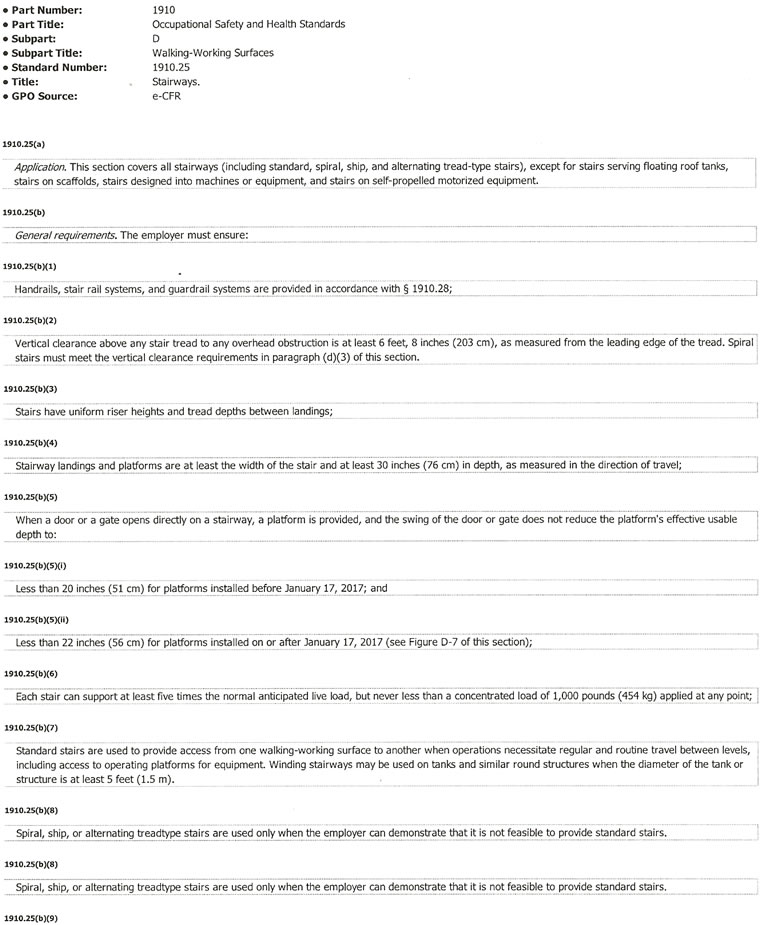 |
|
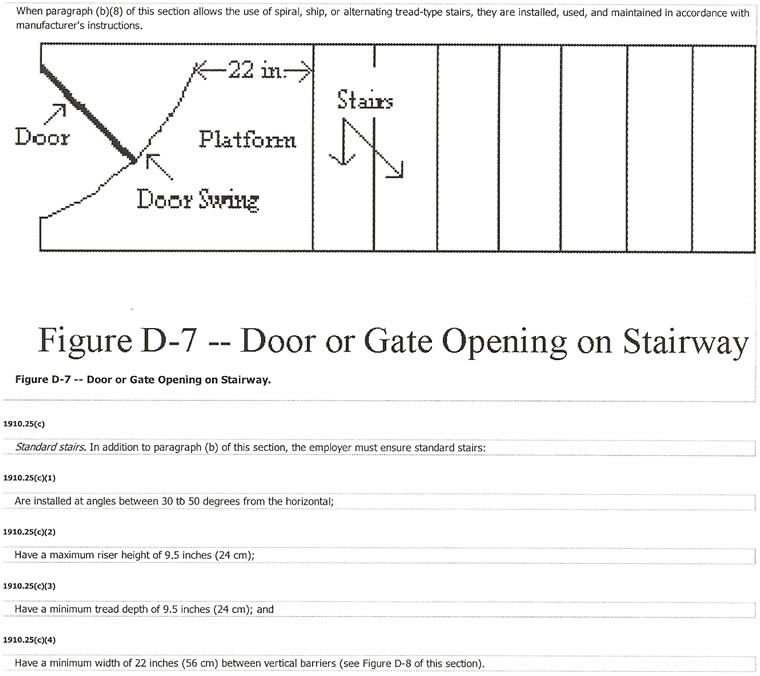 |
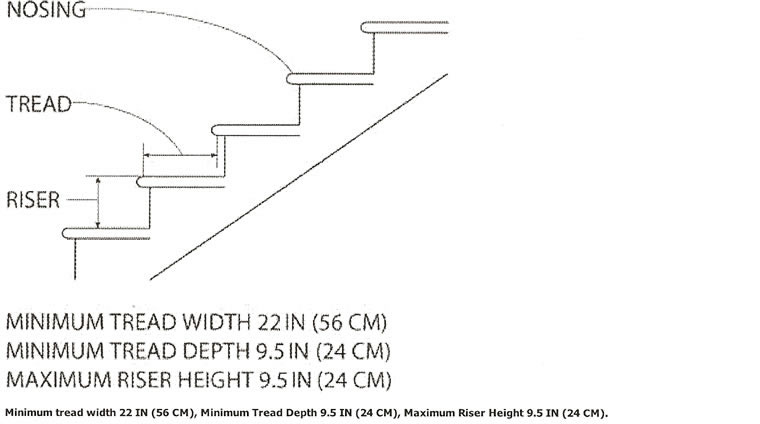 |
 |
|
Walking-Working
Surfaces and Personal Fall Protection Systems Final Rule
Frequently Asked Questions |
The
intent of OSHA’s Walking-Working Surfaces standard, 29 CFR Part 1910,
Subpart D & I, is to increase the
protection of general industry employees and employers from hazards associated
with walking-working surfaces. The
rule making will significantly reduce the number of worker deaths and injuries
that occur each year resulting from
workplace slip, trip, and fall hazards. The final rule was published on
November 18, 2016, and became effective on
January 17, 2017. Some requirements in the final rule have compliance dates
after the effective date and will be
discussed in further detail below. This final rule and the associated preamble,
providing more detailed explanation of
the rule, is available on the Federal Register website at 81 FR 82494, Walking-Working
Surfaces; Personal Protective
Equipment; Final Rule, November 18, 2016.
OSHA requirements are set by statute, standards, and regulations. The Agency’s
interpretations explain these require-
ments and how they apply to particular circumstances, but they do not create
additional employer obligations. Note
that our enforcement guidance may be affected by legislative or rule making
changes to OSHA requirements. Also,
from time to time we update our guidance in response to new information.
To keep apprised of such developments,
you can consult OSHA’s website at http://www.osha.gov.
This webpage provides guidance, in a question and answer format, regarding
OSHA’s Final Rule, Walking-Working
Surfaces and Personal Protective Equipment, 29 CFR Part 1910, Subpart D
and I. These Frequently Asked Questions
(FAQs) are divided into five sections: general questions, rope descent system
(RDS) questions, outdoor advertising
questions, residential roof questions, and agricultural operation questions. |
| Standard
Stairs |
Does
the exception to the 9.5-inch riser height and 9.5-inch tread depth requirements
for stairs installed before
January 17, 2017 (§19210.25(c)(5)), also apply to stairs designed and
fabricated, but not yet installed, by that date? |
Stairs
with design drawings issued for construction or that were in fabrication
before January 17, 2017, but not
installed, will be in compliance if they met the previous requirements for
standard stairs. |
|
Under
the previous standard, stairs with a handrail that doubles as a stair rail
could have a rail height of 30 to 34
inches. If an employer's stairs were installed prior to January 17, 2017,
must the rails have a minimum height of
36 inches if the stair rail doubles as a handrail? |
The
final rule does not affect stair rail systems and handrails installed before
January 17, 2017 that were in com-
pliance with the requirements in the old standard. |
|
Does
the requirement that standard stairs have a slope between 30 to 50 degrees
apply to stairs installed after January
7, 2017. Therefore, the maximum angle for standard stairs is 45 degrees. |
Yes.
The final rule limits the maximum rise height and minimum tread depth to
9.5 inches for standard stairs installed
after January 17, 2017. Therefore, the maximum angle for standard stairs
is 45 degrees. |
|
| Are
stairs installed after January 17, 2017, that have an angle of 50 degrees
considered to be ships stairs? |
The
final rule defines ship stairs as “a stairway that is equipped with
treads, stair rails, and open risers, and has a slope
of 50 to 70 degrees.” Ship stairs must also comply with §1910.25(b)
and (e), such as a minimum tread depth of 4
inches, a minimum tread width of 18 inches, and a vertical clearance above
any stair tread to any overhead
obstruction of at least 6 feet 8 inches. |
|
What
if the doorway described in §1910.25(b)(5)(ii) and shown in figure
D-7 is perpendicular to the direction of
travel and opens onto the landing? Does the same dimension apply to this
condition? |
Yes.
As figure D-7 illustrates, Section 1910.25(b)(5) requires that a platform
be provided when a door or a gate opens
directly onto a stairway. For platforms installed after January 17, 2017,
the final rule also requires that employers
ensure the swing of the door or gate does not reduce the "effective
usable depth" of the platform to less than 22 inches (§1910.25(b)(5)(ii)).
The preamble to the final rule describes “effective usable depth”
as the portion of the platform
beyond the swing of the door where a worker can stand when opening the door
(82 FR 82557). The provision applies
equally to stairway doors that are perpendicular to the direction of travel. |
|
Are
fixed stairs attached to the exterior of tanks required to comply with the
requirements of §1910.25(b) or would
those stairs fall under the exemptions in §1910.25(a)?
The exception from the stair requirements in §1910.25(a) only applies
to stairs serving floating roof tanks, stairs on
scaffolds, stairs on self-propelled motorized equipment, or stairs designed
into machines or equipment. For stairs on
the exterior of other tanks, employers would have to ensure they comply
with the requirements in §1910.25(b) and (c). |
|
Would
winding stairs attached to tanks be required to meet the requirements in
§1910.25(d) for spiral stairs?
No. Section 1910.21(b) defines spiral stairs as a "series of treads
attached to a vertical pole in a winding fashion,
usually within a cylindrical space" (emphasis added). Winding stairs
attached to tanks do not have vertical poles;
therefore, they are not spiral stairs and must meet the requirements of
§1910.25(b) and (c). |
|
Based
on the height requirements for stair rails and handrails and the requirements
in Table D-2, are both stair rails
and handrails required on stairs that have two open sides and are less than
44-in. wide?
Yes. Section 1910.28(b)(11)(ii) Table D-2 contains a printing error, which
OSHA will correct in a published notice.
For each flight of stairs with two open sides and a width of less than 44
inches, column 4 of Table D-2 should state
"One stair rail system with hand rail on each open side" is required.
(See 81 FR 82611-12). |
|
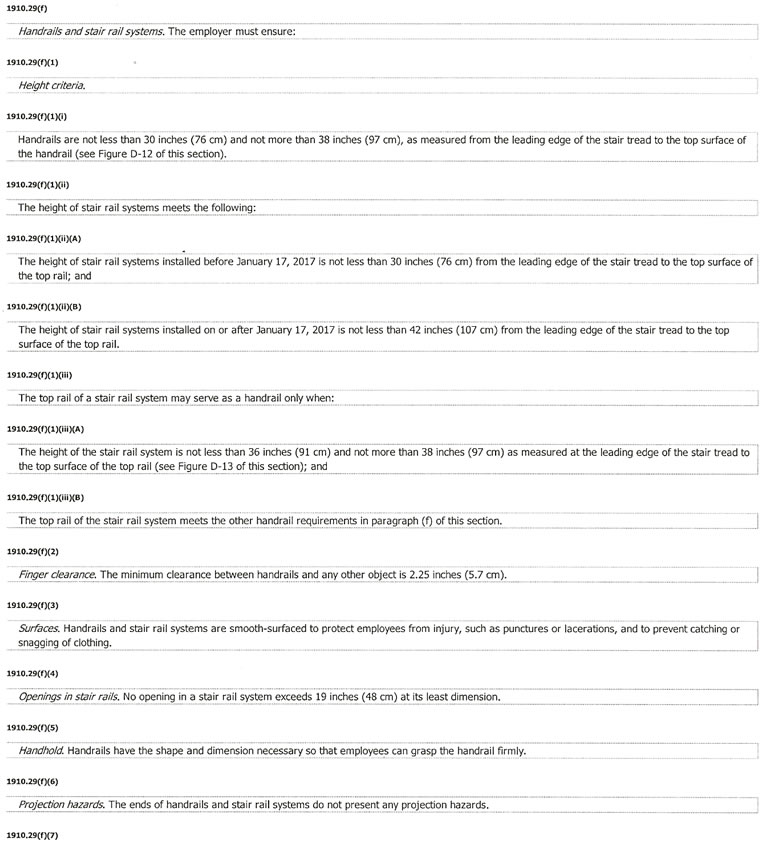 |
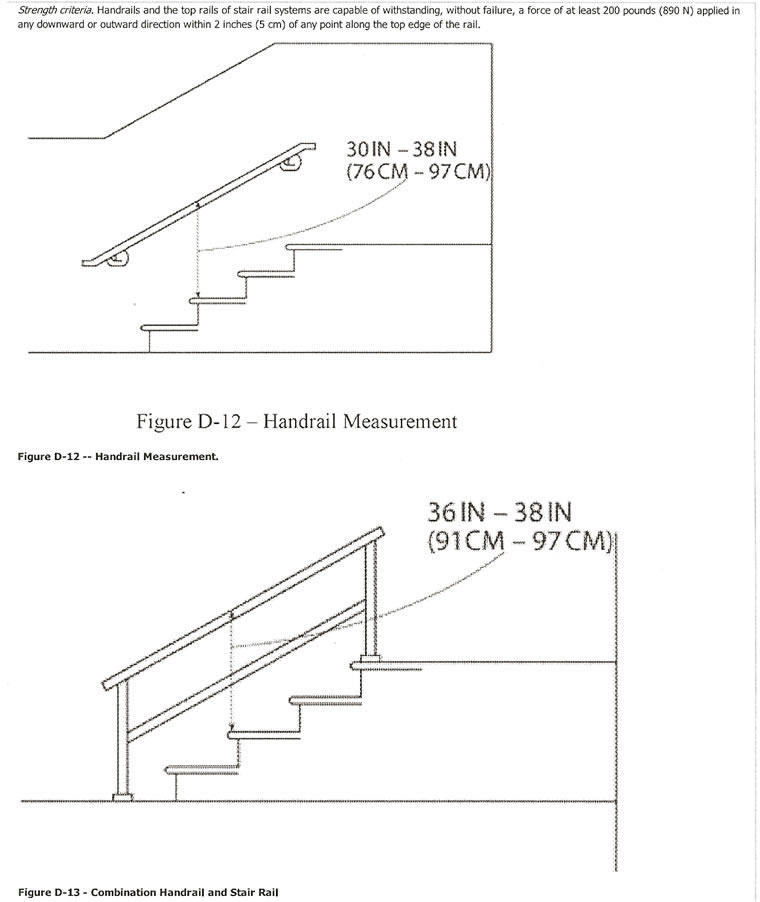 |
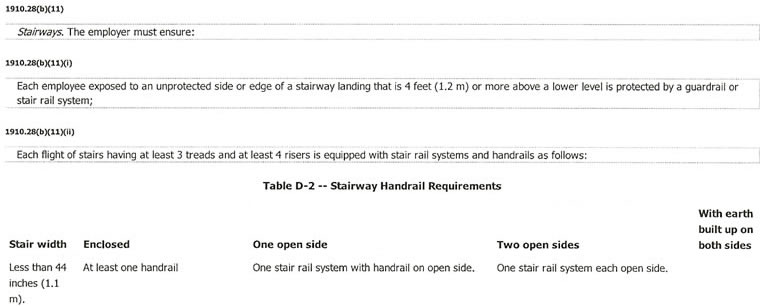 |
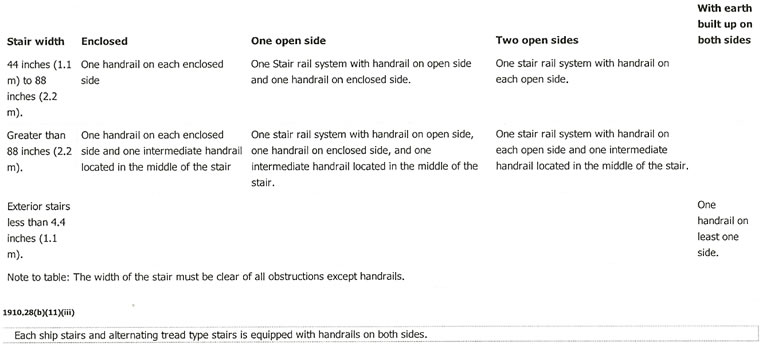 |
|
IBC Prefab Stairways, Commercial
Stair, Galvanized Stairs, Industrial Stair, Metal Stair, Open Tread Stair,
Out Door Metal
Stair, Outdoor Metal Stairs, Prefab Metal Stairs, Prefabricated Stair,
Steel Pan Stairs, Steel Stairways, and Steel Stairs from
your complete source for material handling equipment. |
Back to Product Category
|



